Trellised vines make good wind blocks
Q: I was hoping to put up a nice strong wind and sun block on the west and southwest corner of our front yard, approximately 20 feet each way. Could you give me some suggestions? I’ve talked to the neighbor on that side and we were thinking probably some kind of large bush.
A: Windbreaks and screens for sunlight in the desert are usually best if they are close to the affected area. The reason is that plants used for screening or deflecting wind have to be pretty big to do any good when they are far away.
Larger plants require more water. If you put a windbreak close to the area where wind is a problem, then you can use smaller windbreaks and smaller plants to achieve the same thing. If wind or sun is a problem all year long, then you would select evergreen plants.
If this problem is seasonal, you would select deciduous plants that drop their leaves in the fall and allow wind or sun through during winter months.
A general rule of thumb is that wind is affected on the downwind side of a windbreak from five to eight times its height, depending on the type and direction of winds.
To be effective, windbreaks made from plants should be at least two layers thick . The majority of wind will be diverted over the top, under the bottom and around the sides of windbreaks. Wind that does go through a porous windbreak will be slowed.
How much it is slowed depends on how porous the windbreak is. Try to achieve about 20 percent porosity . This lets wind through it, slows it and decreases the amount diverted up or around a windbreak.
In the desert, think about structures to do this more than plants. These structures would be things like walls or trellises that can be covered with vines rather than large plants. A vine covering a wall or trellis will use far less water than plants the size and density needed to reduce wind speed and sunlight.
Also, using a structure and vines or small shrubs in combination will achieve a more permanent solution to the problem and occupy less space in small residential landscapes. Avoid wood structures that crack in our dry heat. Instead use cement and metal options that are more resistant to our harsh environment.
Q: Four years ago, we planted two Raywood ash trees in our backyard. They have been very healthy and have grown wonderfully to more than 25 to 30 feet. One is growing in the grass; the other in decorative rock. We usually water about 30 gallons every 2½ weeks in the summer. Both trees are planted in a wide circle of dirt and mulch, about 25 feet apart. There are no other plants near these trees, so they are not susceptible to any weed killer or fertilizer that should not be used near trees. They seemed to be fine after our week of 117 degrees Fahrenheit weather.
Two weeks ago, one began to lose leaves. Now the other one is doing the same thing. We gave them a little extra water because the leaves are beginning to dry, feel like crepe paper and turning yellowish. We checked the limbs and bark and there doesn’t seem to be any seepage, cuts or insect damage.
A: My first reaction is the trees are not getting enough water. When leaves begin to drop over the entire tree it usually points to a problem with the trunk or roots. Since water affects the entire tree, the amount of water applied is also looked at closely.
Thirty gallons every 2½ weeks is not enough for trees 25 to 30 feet tall. So they must be getting water from somewhere else besides your deep watering. It is good to water trees infrequently but every two weeks is quite extreme for trees that have no other source of water.
I would normally give 30 gallons of water three times a week when temperatures are in the 110 degrees Fahrenheit range. Once the temperature drops back around 100 degrees Fahrenheit, I would drop it to twice a week.
As long as this amount of water is spread in a 3- to 4-foot-diameter basin under the tree or distributed by multiple drip emitters under the canopy it should wet the soil deep enough, about 2 feet down.
You might consider that the extra water the trees were getting might have “dried up” for some reason. When this happens, the leaves on the tree would scorch, dry up, turn crispy and drop. This leaves the roots to rely on other sources of water to support their size.
When tree roots find water, the roots expand into a wet area. Tree roots can spread, if water is present, distances of two to three times their height. So your 25 foot Raywood ash could have roots as far as 75 feet away from the trunk. In areas where very little water is present, tree roots grow poorly.
Tree roots do not necessarily grow symmetrically around the trunk. The greatest abundance of roots is in wet areas of your landscape or your neighbors. Also, if your neighbor had a pretty wet landscape, the roots could be over there. If that is the case, how your neighbor waters, or doesn’t water, could affect your trees.
I would construct a basin under your trees 4 to 5 feet in diameter and deep enough to hold 30 to 40 gallons. I would fill this basin with water once a week for the next several weeks.
Leaves that are crunchy will not grow back. They will dry and fall from the tree. You will have to wait for a new flush of leaves if water is the problem .
To help the tree you can plant other plants that require watering under the canopy . This will supplement the amount of water that trees require.
The tree in the lawn is puzzling. This would make you think there is another problem. But if things happen to both trees it usually points to a management problem with water, fertilizer, pesticides, etc.
When one tree is affected, it usually points to outside factors that are more hit-and-miss, such as diseases. However, ash is not affected by that many diseases and is a good tree for Las Vegas.
Bob Morris is a horticulture expert living in Las Vegas and professor emeritus for the University of Nevada. Visit his blog at xtremehorticulture.blogspot.com.























